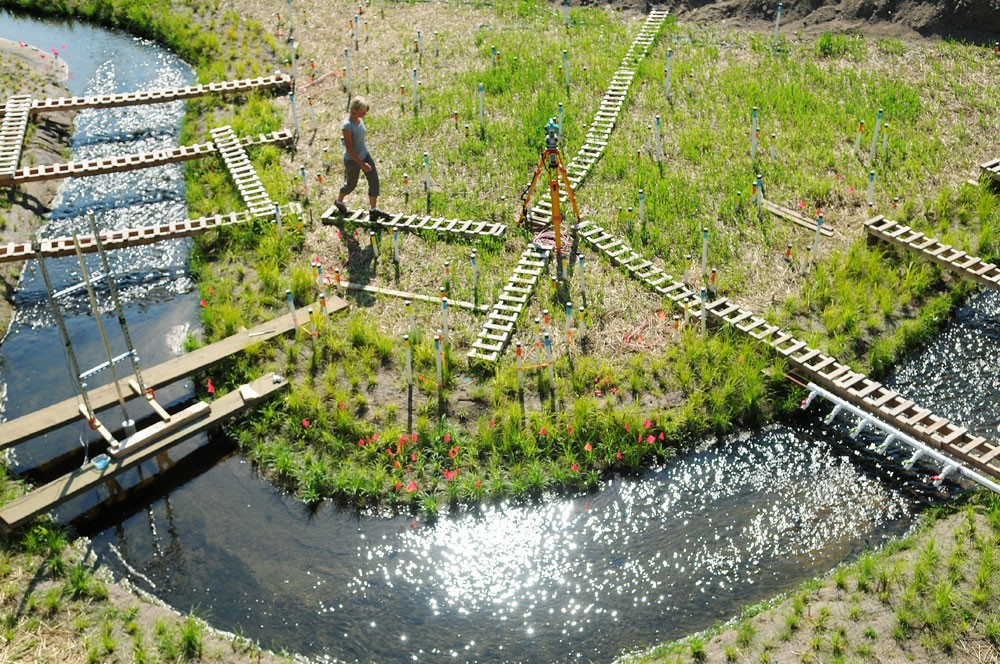A computer, shielded from the sun with a maroon and gold umbrella, sits next to the small stream. A submerged video camera monitors the status of blue pellets as the current prods them along the stream bed. Although the stream is outside, researchers can control how fast water flows through it âÄî and how that affects the movement of those blue pellets. The Outdoor StreamLab at the UniversityâÄôs St. Anthony Falls Laboratory is an outdoor, artificial stream where researchers can control stream flow and watch as the ecosystem responds. Dubbed the âÄúMini-ssippiâÄù by some researchers, its public opening is Friday at 3 p.m. Water is channeled from the Mississippi River into a small pool at the head of the stream. From there, researchers can control how much water flows ahead as it winds through the 130-foot-long basin . A system at the streamâÄôs exit can collect and recirculate sediment thatâÄôs been put in the stream for experiments, and the rest flows back into the Mississippi. The most important thing to come from the StreamLab so far, which has been operating since June 20, is confirmation that the artificial stream is in fact replicating the ecosystem, Fotis Sotiropoulos, St. Anthony Falls Laboratory director , said. In the ecosystem, many things are tied together in a way that indoor facilities canâÄôt replicate, said Sotiropoulos. It also gives researchers more control than they have in the field âÄî while field researchers have to wait for rain to study flooding, StreamLab researchers can do so at their convenience, which means that more research can be done in a short period of time, John Gaffney , civil engineering graduate student, said. âÄúThe first time we had a [StreamLab] flood, it also started to rain heavily, so some people were commenting that we were controlling the weather âÄî but that didnâÄôt happen every time,âÄù Gaffney said. He added that using dams to control and study real streams has negative effects on ecosystems. However, with the StreamLab, âÄúwe can make this fake stream and we can change it, we can abuse it, we can rebuild it âÄî we donâÄôt have to worry about ruining a nice little piece of ecosystem out there in the real word,âÄù Gaffney said. With 45 percent of the 3.5 million miles of rivers in the U.S . degraded and in need of restoration, StreamLab research looks to inform decision makers to address issues of flood control and water quality, StreamLab project manager Anne Lightbody said. Although it may not seem like humans have a lot of control over the way water moves around in the real world, Lightbody said activities like urbanization can actually have a huge effect on how much water flows into rivers and streams and when it gets there. For example, when rain falls on a mall parking lot, nearby rivers experience a quick influx of water that erodes the riverbanks, Lightbody said. This can also increase the severity of flooding, Sotiropoulos said. If rain water is instead taken up by the ground, it reaches water channels more slowly, lessening the chance of flooding, he said. This would also improve stream health, something Gaffney is researching. A common measure of stream health is the cloudiness of the water, but Gaffney said that measure might not give sufficient information to make policy decisions about stream restoration. He said itâÄôs also important to analyze the stream bed, something he can do at the StreamLab. The artificial stream was modeled after the average Midwest metro-area stream, so results can be applied to many creeks that drain from the metro area into the Mississippi or St. Croix rivers. ItâÄôs the only facility of its kind in North America, but there is a similar one in Japan, said Maia Homstad, SAFL science writer . She called it a resource for professors and students in a variety of fields, and added that over the summer, 10 students in ecology, geology, engineering and other fields did research there. Speeches by University President Bob Bruininks and a ribbon cutting will be followed by tours of the StreamLab Friday afternoon.

Image by Tara Sloane
Research assistant Katie Kramarczuk surveys the stream at the new Outdoor StreamLab at the University’s St. Anthony Falls Laboratory. StreamLab research looks to inform decision makers to address issues of flood control and water quality.
“Mini-ssippi” has grand opening
Published September 19, 2008
0

